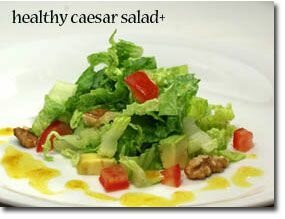If you don't know what to serve for dinner tonight ...
You can add or substitute any of the vegetables with your personal favorites or use what you have on hand. This is a healthy version of a Caesar salad that is only limited by your imagination.

Ingredients:
- 4 cups chopped mixed greens (spinach, romaine, arugula)
- 2 oz chicken or turkey slices
- 1 medium tomato, chopped or sliced
- 1/4 cup cucumbers, sliced
- 1/4 cup crimini mushrooms, sliced
- 1 cup or 1/2 can (BPA Free) kidney beans
- 1 TBS dried sunflower seeds
- Dressing
- 2 TBS fresh lemon juice
- 1/2 TBS extra virgin olive oil
- 1 clove garlic, pressed or chopped
- 1 TBS parmesan cheese
Combine all ingredients and top with dressing.
Serves 1
Printer Friendly Version of Healthy Chicken Caesar Salad
In-Depth Nutritional Profile for Healthy Chicken Caesar Salad
Healthy Food Tip
The Latest News About Quinoa
Perhaps the most striking health benefit provided by quinoa is
its overall nutrient richness. When the nutrient composition of this
food is analyzed in depth, the results are unusual and striking. While
quinoa can be eaten in the same way as a grain, or ground into flour
like is so commonly done with grains, studies are finding it to have
important differences.
What's New and Beneficial About Quinoa
- The Food and Agricultural Organization of the United Nations (FAO) has officially declared that the year 2013 be recognized as "The International Year of the Quinoa." Proposed by the government of Bolivia and receiving strong support from many Central and South American countries, quinoa has now been singled out by the FAO as a food with "high nutritive value," impressive biodiversity, and an important role to play in the achievement of food security worldwide. We realize that quinoa remains unfamiliar to many people, especially in the practical sense of cooking and recipes. But we hope that situation will change, given the remarkable nature of this easily-prepared, nutrient-rich food.
- Researchers have recently taken a close look at certain antioxidant phytonutrients in quinoa, and two flavonoidâ€"quercetin and kaempferolâ€"are now known to be provided by quinoa in especially concentrated amounts. In fact, the concentration of these two flavonoids in quinoa can sometimes be greater than their concentration in high-flavonoid berries like cranberry or lingonberry.
- Recent studies are providing us with a greatly expanded list of anti-inflammatory phytonutrients in quinoa. This unique combination of anti-inflammatory compounds in quinoa may be the key to understanding preliminary animal studies that show decreased risk of inflammation-related problems (including obesity) when animals are fed quinoa on a daily basis. The list of anti-inflammatory phytonutrients in quinoa is now known to include: polysaccharides like arabinans and rhamnogalacturonans; hydroxycinnamic and hydroxybenzoic acids; flavonoids like quercetin and kaempferol; and saponins including molecules derived from oleanic acid, hederagenin and serjanic acid. Small amounts of the anti-inflammatory omega-3 fatty acid, alpha-linolenic acid (ALA), are also provided by quinoa.
- In comparison to cereal grasses like wheat, quinoa is higher in fat content and can provide valuable amounts of heart-healthy fats like monounsaturated fat (in the form of oleic acid). Quinoa can also provide small amounts of the omega-3 fatty acid, alpha-linolenic acid (ALA). Given this higher fat content, researchers initially assumed that quinoa would be more susceptible to oxidation and resulting nutrient damage. However, recent studies have shown that quinoa does not get oxidized as rapidly as might be expected given its higher fat content. This finding is great news from a nutritional standpoint. The processes of boiling, simmering, and steaming quinoa do not appear to significantly compromise the quality of quinoa's fatty acids, allowing us to enjoy its cooked texture and flavor while maintaining this nutrient benefit. Food scientists have speculated that it is the diverse array of antioxidants found in quinoaâ€"including various members of the vitamin E fam ily like alpha-, beta-, gamma- and delta-tocopherol as well as flavonoids like quercetin and kaempferolâ€"that contribute to this oxidative protection.
Health Benefits
Quinoa provides numerous health benefits including:
- Complete protein
- Overall nutrient-richness
- Antioxidant benefits
- Anti-Inflammatory benefits
Nutritional Profile
Quinoa is food of high protein quality and is typically regarded as
an adequate source of all essential amino acids, including lysine and
isoleucine. It provides a variety of antioxidant phytonutrients,
including ferulic, coumaric, hydroxybenzoic, and vanillic acid.
Antioxidant flavonoids including quercetin and kaempferol are also
especially plentiful in quinoa. Anti-inflammatory polysaccharides in
quinoa include arabinans and rhamnogalacturonans. Many members of the
vitamin E tocopherol family are provided by quinoa, including important
amounts of gamma-tocopherol. Quinoa is a very good source of
antioxidant-promoting manganese. It is also a good source of
heart-healthy magnesium, folate, and fiber, as well as bone-building
phosphorus and copper.
For more on this nutrient-rich vegetable, including references related to this Latest News, see our write-up on Quinoa.


No comments:
Post a Comment